On the eve of the vote [updated]
April 8, 2011
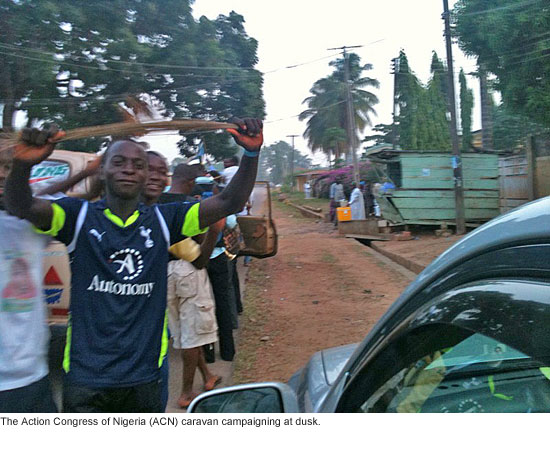 Tomorrow is Election Day in Nigeria.
Tomorrow is Election Day in Nigeria.
So today I’m crisscrossing the capital city of Nigeria’s Kwara state, Ilorin, with my partner, Jennifer Cooke, of the Washington-based Center for Strategic Studies. We’re visiting political party officials, journalists, the election commission chairman for Kwara state (who’s got a big job), and local government officials, among others.
Our goal is to gather as much intelligence and ground-based information as we can on what folks think will happen when Nigerians head to their polling places on Saturday. We want to know where, if anywhere, trouble or problems are expected. Jennifer, John (our local chaperone) and I will aggregate that information tonight and chart our observation route. We’ll hit the road at dawn, visiting polling places to observe how the process is working, including whether ballots and other vital election materials have arrived on time and whether people are able to check in and vote without any major hiccups.
As we work through our route, we’ll also decide what specific polling station we’ll track to the next level—the regional tabulation center, which is the equivalent of our voter registrar’s office—to make sure the counts are the same in both locations.
All this is a time consuming and physically taxing process, and we’ve gotten little sleep. The good news is that Jennifer is a sub-3:20 marathoner and I do my share of running, too. So our stamina is holding up in the tropical heat.
(A sidebar to all this is that Jennifer was scheduled to run the Boston marathon the week after next, but she’s staying in Nigeria to monitor the postponed Presidential balloting a week from tomorrow. Now, that’s commitment to Nigerian democracy.)
A few observations of Ilorin and its environment:
Nigeria is one of the poorest nations on the globe, and that was evident on our drive in from the airport. For the vast majority of locals, life is rudimentary at best. By our standards, one would characterize the population as economically poor. We are told that there’s a small but growing middle class, but it’s hardly noticeable. Then there’s the large concentration of wealth in the hands of a few. Their homes, or estates, would be the envy of Beverly Hills or Bel Air. Incredibly, one home has its own mosque on the front of the property.
In much the same way that race influences interpersonal relations in the U.S., religion and tribal rivalries can often divide Nigerians. Kwara state is majority Moslem with a significant, but decidedly minority, Christian population. There are two tribes that dominate here—the Yoruba and the Hausa-Fulani. Their languages are distinct and utterly unrelated to each other. There’s no reticence of either to stereotype the other.
This sort of thing always makes me nervous because of where it can lead. Those of us who are old enough to remember can recall the civil war with Biafra in the late 1960′s, when tens of thousands civilians were killed and millions of the defeated Igbo tribe were rendered refugees.
In short, this election represents another threshold moment in the evolution of civilian and democratic government in this, Africa’s most populous nation. No one expects the election will go perfectly. Few ever do in emerging democracies. It will be a success, though, if there’s a marked improvement over the last three national elections in 1999, 2003 and 2007. Success will be an election with minimal violence and a credible result, based on a smooth and transparent process that allows Nigerians to elect and believe they have elected candidates of their own choosing.
If Nigeria can pull this off, it will help build public confidence in the institutions vital to any sustainable democracy. This is a building block in the construction of that democracy. They have a long way to go, but there are a lot of Nigerians determined to get there.
You will next hear from me after the election, most likely after the National Democratic Institute has debriefed its observers back in the Nigerian capital, Abuja, on Sunday and Monday. Then, I’ll be headed home to turn my attention back to our own county and my new granddaughter.10
Updated 4/8, 10 p.m.: Sadly, a bomb exploded Friday at the Independent National Electoral Commission office in Suleja in central Nigeria, according to media reports, including this one from CNN. Eight people reportedly died in the attack, the latest in a series of violent acts aimed at derailing democracy in Nigeria.
In Kwara state, where I’m observing the national elections, there has been no reported violence or a history of the kind of deadly attacks that have erupted elsewhere during the past two days. So forward we move.
Photos from Supervisor Zev Yaroslavsky
Posted 4/8/11
Hot pursuit in the toy aisle
April 7, 2011
 Sheriff’s work is no child’s play. But at 1/64th scale, their cars can be.
Sheriff’s work is no child’s play. But at 1/64th scale, their cars can be.
A fleet of “Hot Wheels”- style L.A. County Sheriff’s cars, complete with the trademark star and “A Tradition of Service” slogan, are coming soon to a Wal-Mart near you.
The Los Angeles County Board of Supervisors this week approved a deal between the Sheriff’s Department and Jada Toys Inc. to create the die-cast cars, which will be part of the company’s “Heat” line of law enforcement vehicles.
Under the deal, a Sheriff’s Department training fund will get 5% of gross revenues from the sale of the tiny cars.
“I think they will do very well. Police vehicles have been very popular for the past few years,” said Jason Richman of Jada Toys. He’s not sure why but they seem to be equally popular with kids and adult collectors. And the market is split between realistic cars (like the L.A. County Sheriff’s Department model) and generic or fantasy cars.
“Someone will take a Corvette and make it look like a police car,” Richman said.
He said his company plans an initial run of 15,000 cars. The toys will be produced in China, and Richman hopes to have them in Wal-Mart stores nationwide in time for the holiday season. They’ll retail for $3.99, he said.
Sheriff’s deputy Bill Brauberger said that a realistic depiction of the car was important to the department.
“Our perspective is we wanted it to be similar to what we actually have,” he said. “When your department is as large as ours, it’s good to have kids playing with them. We wanted them to look factually accurate, not bogus.”
The five-year contract can be extended for another five years if all goes well.
It’s not the first time the Sheriff’s Department has gotten into the toy vehicle game. In 2005, supervisors authorized a Hong Kong firm, Sunnyside Ltd., to use the sheriff’s star and slogan for another line of toys. Deputy County Counsel Paul Yoshinaga said the company created 6” replicas of the buses that the department uses to transport inmates. He said the county received about $12,400 from Sunnyside.
Posted 4/7/11
Rape survivors have a Hollywood friend
April 7, 2011
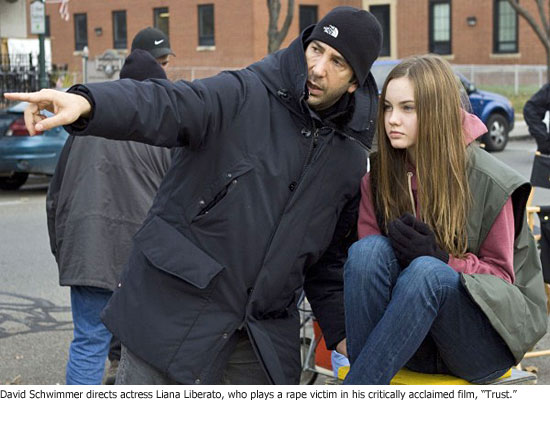 Fourteen years ago, as a star on the hit TV show “Friends,” David Schwimmer agreed to appear in one of NBC’s “The More You Know” public service announcements.
Fourteen years ago, as a star on the hit TV show “Friends,” David Schwimmer agreed to appear in one of NBC’s “The More You Know” public service announcements.
The request came from Gail Abarbanel, founder and director of the Rape Treatment Center at Santa Monica-UCLA Medical Center. And the more Schwimmer got to know about the center, he says, the more inspired he became.
“Two former relationships I had were with women who had been victims of child sexual assault,” he remembers, “and one had also been a victim of date rape. And it was also at a time when I was in that first flush of celebrity, and being approached by dozens of people who wanted me to loan my celebrity to their causes.”
Searching for a place where he could make a real difference, Schwimmer says, he found himself “just amazed by the work Gail and others at the center were doing.”
The PSA—on date-rape drugs—ended up being just a beginning. Last week, Schwimmer, now a director, released “Trust,” a family drama steeped in his work with the center and its funding arm, the Rape Foundation, where he has been a board member for the past decade.
“There are just countless things in the film that reflect the work and the goals of the Rape Treatment Center,” says Schwimmer, speaking by phone from New York, where he and his wife, photographer Zoe Buckman, are expecting their first child.
The movie—about a 14-year-old girl’s life-altering encounter in an online chat room—features acclaimed performances by Catherine Keener and Clive Owens, two of Hollywood’s most skilled actors. But in many ways, the Rape Treatment Center is a star, too.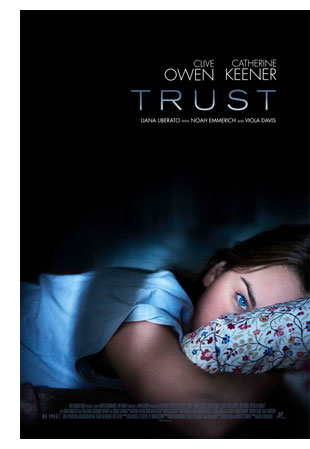
Located on Sixteenth Street in Santa Monica, the center for years has provided free state-of-the-art treatment, counseling and forensic services for sexual assault victims, as well as training for law enforcement and educational and prevention programs. It’s still the only facility in Los Angeles—and one of the few in the country—where sexual assault victims can receive services 24 hours a day, in one place.
Among its most innovative programs is Stuart House, a special facility for children that has become a national model for treating and interviewing child victims and coordinating services so kids don’t have to be re-traumatized by multiple interviews with police, prosecutors and child protection workers.
Schwimmer says the center’s work informed the script on many levels, from the dialogue to the portrayal of police procedure to the way a crime can impact every member of a family.
At one point, a character diminishes the impact of an acquaintance rape because the attacker didn’t use physical violence—a misconception commonly dealt with at the center. At another, an investigation is delayed by a massive backlog of untested “rape kits,” like the tens of thousands that had been warehoused in Los Angeles.
An FBI agent in the film is named for Doug Hunt, a real FBI agent who for years was a consultant to the center, says Schwimmer. And a therapist named “Gail” has a key role in the story.
“She and I have become really close,” Schwimmer says of the real Gail, who founded the Rape Treatment Center in 1974 and has shepherded it into a national model for rape treatment. “She works harder and longer and more passionately than any person I’ve ever met in any profession. She’s the most selfless person I’ve ever met. She really is an inspiration to me.”
The feeling is mutual, says Abarbanel. “I really feel like David took so much of what he’s been a part of for all these years, and incorporated it into this great film. I have gotten so much feedback from people on this movie. It really brings home so many issues parents deal with, so many questions about how to keep your kids safe.”
Although the performances have drawn raves, the early box office has been modest. “I knew it would be a challenge to get people into the theater,” says Schwimmer, “but it’s a great dramatic story.”
And an important one, he and Abarbanel add: One in six women has been a victim of rape or attempted rape. One in four girls, and one in eight boys, is sexually assaulted before they reach 18.
“My hope was not only that people would be moved and entertained, but that it would invite more discussion between parents and kids on a whole range of issues,” says Schwimmer, especially about the dangers of the Internet.
“It used to be that when some stranger came to your door, you could look out the peep hole and tell him to go away,” he says. “Now there are a hundred strangers knocking on your kids’ door every day. And you’re not always going to be there to intervene.”
Posted 4/6/11
An heiress with heart
April 7, 2011
There’s not a whiff of wealth around Aileen Getty. Her fingers are circled not with diamonds but with intricate tattoos. She wears bright yellow sneakers and sanely-priced jeans. Her face is free of makeup, warm and welcoming.
Aileen Getty’s grandfather was the billionaire oil baron J. Paul Getty. But these days she has found richness in her life on the far margins of society. A former heroin and cocaine addict who has been living with AIDS for more than two decades, she has emerged as arguably the most influential friend and benefactor of the homeless of Hollywood.
“I’ve been able to grow alongside them,” she says, “while they grow alongside me.”
During the past five years, Getty, 51, has quietly contributed millions of dollars to provide housing and food for Hollywood’s entrenched homeless population through her Gettlove organization and through gifts and loans to several other advocacy groups. By all accounts, she’s changed the landscape.
Getty says her own “inability to get well” has created in her a natural affinity with those struggling on the streets, most of whom are plagued by mental health and substance abuse problems.
“I’ve been an addict most of my life,” says Getty, who celebrated five years of sobriety on Valentine’s Day last month. “In my own journey, I really felt like I could either die or say, ‘Thank you and I’m sorry.’ I felt I had taken far more than I’d ever given. I didn’t want to go out that way…I rewrote my interior geography. That geography is now about others. ”
Gettlove, founded in 2005, has provided a variety of housing alternatives, depending on the needs of its clients. That includes refurbishing 30 rooms at two 1920s-era Hollywood hotels and lining up apartments for nearly two dozen homeless people in an aging Santa Monica Boulevard building. There, Gettlove staffers help tenants manage their finances and adjust to life with a roof.
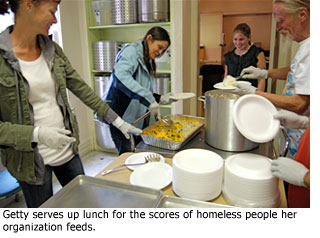 At the same time, Getty individually has funded other organizations—Step Up On Second, PATH and Housing Works—to help them develop permanent housing for residents who simultaneously receive such services as health and mental health care. This month, Getty’s efforts led to her being honored as “woman of the year” for Supervisor Zev Yaroslavsky’s Third District.
At the same time, Getty individually has funded other organizations—Step Up On Second, PATH and Housing Works—to help them develop permanent housing for residents who simultaneously receive such services as health and mental health care. This month, Getty’s efforts led to her being honored as “woman of the year” for Supervisor Zev Yaroslavsky’s Third District.
Underlying all of Getty’s financial and logistical contributions is her core belief in the power of one-on-one relationships to, in her words, “rekindle the part of a human being that wants to find its best self.”
“Just because we’re housed doesn’t mean our spirit is comfortable,” says Getty, whose organization has taken clients on outings to, among other places, the L.A. County fair and the horse track.
Beyond housing, Gettlove serves hundreds of breakfasts and lunches each week at a social services agency founded by Blessed Sacrament Church in Hollywood. Gettlove shares the Selma Avenue building with several other homeless advocacy organizations, a reflection of the growing coordination among non-profits, business owners and government agencies to reduce homelessness in Los Angeles’ most famous neighborhood. A 2009 count by the Los Angeles Homeless Services Authority found more than 1,000 individuals living on the streets of greater Hollywood, half of them young people.
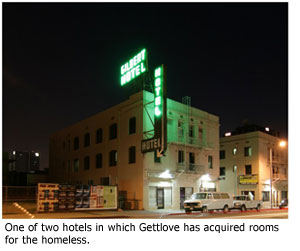 Getty can often be found at Blessed Sacrament’s social services facility spooning out food in the industrial-sized kitchen or mingling with clients in the dusty courtyard. Most have no clue about the family ties of the soft-spoken woman, who treats them as though they were her only family. But some have heard the buzz.
Getty can often be found at Blessed Sacrament’s social services facility spooning out food in the industrial-sized kitchen or mingling with clients in the dusty courtyard. Most have no clue about the family ties of the soft-spoken woman, who treats them as though they were her only family. But some have heard the buzz.
“I hear you’re one of the Gettys. Is that true?” they’ll ask. When Getty says yes, the matter quickly passes because her commitment to them has already become the defining characteristic of their relationship.
“The clients know me for what I do with them each day,” Getty says, “not what I give to them each day.”
That said, Getty also knows her wealth is central to Gettlove’s effectiveness, giving her an edge over traditional service groups that must be accountable to the agencies that fund them. “I’m not dependent on anyone else’s expectations,” she says.
This extraordinary financial freedom allows Gettlove to experiment, to learn what works and then collaborate with government agencies to bring to life these “best practices” models.
Says Getty’s longtime friend and fellow Gettlove board member, John Ladner: “We’re taking advantage of our inexperience. We have the advantage of not too many set-in-stone obstacles.”
Looking ahead, Getty believes that providing homes to the homeless should not be embraced as an end in itself. “Nothing is solved,” she says, “unless we nurture a sense of community.” To that end, she envisions the development of community centers, where the homeless and the newly housed can gather during the day and enjoy the restorative powers that come with companionship and “a true sense of belonging.”
Among other things, she says these centers would offer everything from movies to gardening. “Someplace where people get to laugh,” Getty says—something that, these days, comes much easier in her own life. Says Getty: “I’ve become a more comfortable human being.”
Posted 3/24/11
Spring forward to summer camps in L.A.
April 7, 2011
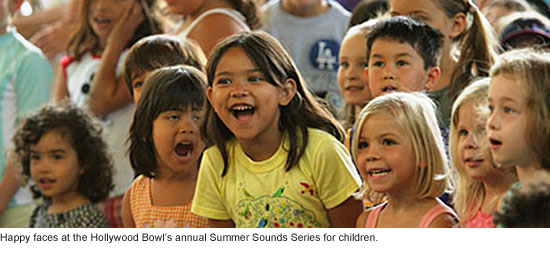 Summers can be a challenge for young families, but there are some great day camps and enrichment programs out there—if you register in the spring.
Summers can be a challenge for young families, but there are some great day camps and enrichment programs out there—if you register in the spring.
That’s the secret that Southern California parents often learn the hard way, usually as panic sets in a week or so before school ends. Fortunately, space is still available at many local day camps and enrichment programs, including some offered by Los Angeles County.
Here’s just a sample of L.A.’s many options. Sign up soon—summer will be here any day.
–Adventures in Nature Day Camp at the Natural History Museum of Los Angeles County is still open to kids from kindergarten to sixth grade between July 11 and August 12, from 9 a.m. to 3 p.m. Activities range from astronomy to trips to the La Brea Tar Pits. Kim Kessler, who is handling camp registration, says a few of the weeks are sold out for younger children, but most still have space—for the moment. Each week costs $250 per child for museum members, $300 for non-members. Click here to get your little nature lover in on the action or call 213-763-3348.
–The Los Angeles County Museum of Art’s popular summer art camp for children filled up within 24 hours after registration opened this year. But if your young artists are teenagers, they’re still in luck. LACMA offers four workshops for teenagers, and they still have openings. Weeklong classes run from 11 a.m. to 2 p.m. in digital photography, mixed media or painting. A month-long workshop focuses on building an art portfolio. Shorter workshops cost $200 a week for members and $225 for non-members. The longer workshop costs $650 for members and $750 for non-members. Click here for an enrollment form or enroll at the museum box office at 323-857-6010. Questions? Call 323-857-6139.
–There’s still room, for the moment, at the Los Angeles County Arboretum’s popular Summer Nature Camp, which offers full or half-days, with extended care starting at 8 a.m. and ending at 5 p.m. Kids aged 5-10 can plant trees, learn to cook from the garden, do arts and crafts, learn about bugs or just explore the Arboretum’s lush 127 acres in Arcadia. The camp runs in one-week sessions from June 3 through Aug. 12. Full-day sessions are $300 a week for members and $335 for non-members; half-day sessions are $150 and $168, respectively. Need more information? Click here or call Ted Tegart, youth education coordinator, at 626-821-5897. Or sign up at 626-821-4623.
–The Mountains Restoration Trust offers yet another day camp for little nature lovers in the Santa Monica Mountains, operated from the 1896 Calabasas farmhouse that now houses the non-profit’s nature center. Susan Haugland, project manager for youth programs, says the Discovery Nature Camp, for kids 8-12, is particularly hands on, with lots of cool guests speakers, field trips and appearances by skunks that can do the moonwalk. Hours are from 9 a.m. to 3 p.m. Monday through Friday, and a weeklong session costs $260. Enrollment is capped at 18 children per week, but registration just opened. Sign up at 818-591-1701 x212.
–The Dolphin Camp and other water awareness camps offered in the past by the county’s Departments of Beaches and Harbors were cancelled this year due to budget issues. But the Los Angeles County Junior Lifeguard Program is still alive and well, sponsored by the Los Angeles County Fire Department. The summer program, offered in half-day morning or afternoon sessions, instructs kids in ocean skills from swimming and surfing to water safety. It’s open to kids aged 9-17 who pass a swim test; pre-registration begins April 25 for the May 7 test in Manhattan Beach. The 5-week program starts June 27. Last year the fee for the summer-long program was $420, but a $56 increase is pending before the Board of Supervisors. For more information, click here or contact the Junior Lifeguard Office at 310-939-7214 or [email protected].
– Registration opens May 3 for the summer day camp at the county’s El Cariso Park in Sylmar, which is open to kids aged 6-12. The camp starts July 1 and lasts until the Friday before school starts in September and—working parents will like this—it goes from 7:30 am to 6 p.m., Monday through Friday. There’ll be field trips, arts and crafts, computer classes and outdoor playtime, plus swimming and sports fundamentals. The price is right, too: $65 a week, plus a $20 registration fee. Sign up at the park office next to Mission College at 13100 Hubbard St. in Sylmar, or call 818-367-7050.
– Want to make a movie? This summer, the William S. Hart Park and Museum and Los Angeles County Arts Commission will offer a free three-day filmmaking workshop for kids aged 10-17. Students will learn about filmmaking, theater, and storytelling, as well as the legacy of local silent film star William S. Hart, as they create their own silent film. The workshop will be taught by instructors from the Canyon Theatre Guild and the CalArts Community Arts Partnership. Space is limited and applications are required. Hours will be 10 a.m. to 2:30 p.m. on July 23, July 30, and August 6. For more information, call 213-202-5858.
–Does a short course in horn playing, tap dancing or classical piano sound fun? The Colburn School in downtown Los Angeles is offering summer camps in all three. The Colburn Academy Festival, a 2-week program, is limited to highly gifted young pianists, but the Tap Intensive, at the school’s downtown Studio B at 200 S. Grand Avenue is open to beginning, intermediate and advanced hoofers from 7-19 during the week of June 27-July 1. And the Horn Camp, a 4-day workshop, is open to horn players of all ages. Need more information? Call 213-621-1085 for the Tap Intensive, 213-621-4554 for the Horn Camp or click here for the piano program.
–The Hollywood Bowl doesn’t do camps, but it does offer a great summer outing for kids and parents (or day care providers) weekday mornings from July 5 to August 12. For just $7 per ticket, kids can watch a concert in the museum patio area, do some fine arts activities and make a morning of it. Or bring a picnic lunch and stay into the afternoon. The Summer Sounds Series will feature classical Korean music for the first two weeks, gospel music for the second two weeks and Irish dance and music for the final two weeks. Click here for more information. Tickets go on sale May 14.
Posted 4/7/11
Film at LACMA ready for its close-up
April 7, 2011
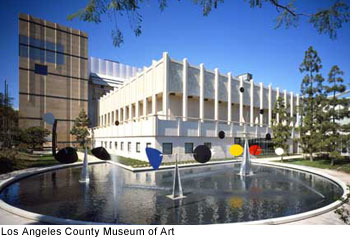 It’s been a real nail-biter for fans of LACMA’s beleaguered classic film program, but it looks like this saga may have a Hollywood ending after all.
It’s been a real nail-biter for fans of LACMA’s beleaguered classic film program, but it looks like this saga may have a Hollywood ending after all.
Not the cavalry, but Film Independent and the New York Times are riding to the rescue, and in true cliffhanger fashion, just in the nick of time.
This could be the start of a beautiful friendship, with Film Independent handling the film programming side of things and the New York Times underwriting the effort. The new arrangement comes as the museum’s film program has struggled in recent years to find its financial footing and build an audience.
Both organizations bring a lot to the table. L.A.-based Film Independent is the non-profit arts organization that produces the Spirit Awards and the Los Angeles Film Festival. LACMA’s tapping the outfit for its programming and curatorial expertise, its marketing and audience-building acumen, and its ties to prominent cutting-edge filmmakers (Film Independent’s president is Bill Condon, director of “Gods and Monsters” and “Kinsey;” its board members include actors Laura Dern, Forest Whitaker and Don Cheadle.)
Plans call for Film Independent’s programming department and a new lead programmer, yet to be named, to work with LACMA’s director and curatorial staff to assemble film series that both showcase artistic achievement and contribute to the cultural conversation about movies.
And, as the sole presenting sponsor of LACMA’s new Film Series, the New York Times will be bringing the national newspaper’s heft and prestige to the project while increasing the paper’s visibility in the world’s film capital.
Speaking by phone from London, Michael Govan, LACMA’s chief executive, explained that the Film Independent-New York Times partnership will be starting out as a one-year commitment, but that Film Independent already is busy developing a 3-to-5-year plan. “It’s been happening pretty quickly,” Govan said. “We’d been doing our analysis and looking at what we should be doing moving into the future. We’d talked to Film Independent early in the beginning, and lately we kind of circled around again and decided they were the perfect choice.”
Govan said the arrangement is “open-ended.” “The idea is to grow the program,” he said, adding that the New York Times has signaled its interest in expanding its initial first-year commitment into a longer relationship.
LACMA’s new partnership is effective immediately. Look for some new programming in September, set to include a wide variety of offerings including dramatic features and documentaries; rarities from the archives; themed series showcasing particular artists; conversations with filmmakers; international showcases; family films; and special guest-curated programs. LACMA is also laying plans for monthly post-screening receptions to create a salon-like setting in which aficionados, artists and the general public can mix and mingle.
LACMA’s current consulting curator in the Film Department, Ian Birnie, is moving on, but patrons will soon enjoy his final series for LACMA, a Tim Burton summer film festival offered in conjunction with a major exhibition and retrospective of Burton’s dark and droll art, sculpture and production design work that opens May 29.
The museum’s popular Tuesday film matinees and individual film programs keyed to special exhibitions will continue.
The new partnership comes as LACMA prepares to host an expanded version of a traveling exhibition and film festival, currently showing in Paris at the Cinémathèque Français, featuring the works of Stanley Kubrick, whose works ranging from “Dr. Strangelove” to “A Clockwork Orange” are widely considered among the most influential in the history of cinema.
LACMA’s longer-range film programming plans are gradually coming into focus. Govan’s goal is to develop “a larger footprint for film” at the museum, in which screenings and exhibitions are at the center of a rotating galaxy of related curatorial, scholarly and social activities.
The new venture situates LACMA in the heart of L.A.’s cultural scene, but as part of an ensemble, not as a soloist. “We’ve been thinking about it a lot, that as times have gotten tougher, non-profit organizations should be doing more collaboration, “ Govan said, calling it “ a viable and exciting strategy in a time when resources for the arts are shrinking.”
Posted 4/7/11
Elizabeth Taylor’s Iranian odyssey
April 7, 2011
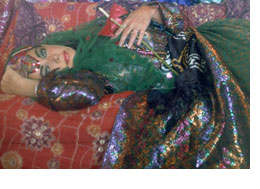 “Elizabeth Taylor as you’ve never seen her before!” press agents might have gushed— and in this case, it would be true.
“Elizabeth Taylor as you’ve never seen her before!” press agents might have gushed— and in this case, it would be true.
In 1976, one of the world’s most famous and glamorous actresses took a low-key excursion to pre-revolutionary Iran. With Firooz Zahedi, a young Persian photographer, in tow, Liz explored the country’s exotic and colorful locales, even posing in traditional costume in character as an odalisque, a Turkish lady-in-waiting to a sultan’s harem.
Zahedi’s photo collection is now on display publicly for the first time at the Los Angeles County Museum of Art, a final tribute to an extraordinary and unique cinematic talent. Plan your LACMA visit here.
Posted 4/7/11
Goodbye, car. Hello, CicLAvia.
April 7, 2011
 Bobby Gadda wants to take your bike.
Bobby Gadda wants to take your bike.
Don’t worry—you’ll get it back. But Los Angeles County’s top “bike valet” and his team will be keeping a close eye on it while you take a breather from Sunday’s CicLAvia—a 7.5 mile, 5-hour free-for-all along city streets usually clogged with cars.
Gadda’s a true believer in the concept; he traveled to Bogotá in 2009 to check out the original ciclovía, in which streets in the South American city are closed to cars every Sunday to allow bikes and pedestrians to roam freely. And he joined a small, pioneering group of other L.A. activists who took the idea and, well, rolled with it.
Los Angeles’ first CicLAvia in October drew tens of thousands of participants and was widely hailed as an instant, improbable hit in a town where automobile culture has long ruled the roadways.
“I was really nervous,” Gadda said. “I thought not enough people would show up. It was amazing. It was just so much fun, seeing all the people who are usually too timid to ride bikes out there.” Indeed, families and once-in-a-blue-moon cyclists made up a good chunk of the crowd.
Sunday’s repeat performance of the free event—from 10 a.m. to 3 p.m. on a route that stretches from East Hollywood to Boyle Heights—is intended to draw participants on bikes, skateboards, strollers and feet to experience Los Angeles in a totally unexpected way.
“It’s not just a bike ride. The idea is to get out there and enjoy the city,” Gadda said. “I’m really looking forward to all of the spontaneous, fun things that happen.”
There are food-related itineraries and historic building-spotting possibilities along the route. Some people have organized a dodge ball game. Others are planning a grapefruit harvest in Koreatown. A book club reading by L.A. Times architecture critic Christopher Hawthorne is set to meet on the 7th Street overpass above the 110 Freeway—along with other more impromptu happenings. “I’ve heard that people will be out there shooting each other with water guns. Last year, a marching band showed up,” said Gadda, who also remembered a giant papier-mâché bull being rolled out and painted by the crowd in October.
And, adding to the communal nature of the event, pop-up groups have organized to ride together along “feeder routes” from various points around town, including Culver City/Palms, Mar Vista, the Fairfax District, UCLA and the San Fernando Valley.
Gadda, who rolled the route last time on his “tall bike”—one frame welded atop another—said that taking away the cars also lowered the decibel level dramatically. “The most amazing thing for me the first time was just how quiet it was,” he said.
Of course, one person’s urban oasis can be another’s public transportation headache. Metro has announced a number of bus detours for affected lines; it also has a list of transit lines providing easy access to the event. (Details on both are here.)
Gadda, 26, who studied philosophy and biology at Reed College in Oregon, is originally from bicycle-friendly Portland. But he said he didn’t become “radicalized” on the subject of integrating bikes onto urban streets until he moved to L.A. three years ago and confronted the traffic here.
After working for a software company in Long Beach, he joined the staff of the Los Angeles County Bicycle Commission, where he now runs the organization’s bicycle valet program.
 On Sunday, Gadda, who’s also a member of CicLAvia’s board of directors, will be hauling out the program’s really long bike racks—large enough to accommodate 200 bicycles—and overseeing the bike valet team in Little Tokyo, outside the Japanese American National Museum.
On Sunday, Gadda, who’s also a member of CicLAvia’s board of directors, will be hauling out the program’s really long bike racks—large enough to accommodate 200 bicycles—and overseeing the bike valet team in Little Tokyo, outside the Japanese American National Museum.
The bike valet is a new addition this year, and may be expanded to other locations in future CicLAvia events.
The free service (there’ll be a tip jar out) will enable participants to drop off their bikes, grab lunch or check out the sights.
Another free service will be offered Sunday by a squadron of “bike angels”—mobile mechanics ready to help riders fix flats, replace chains or adjust seats on their bicycles.
Jason Neville, an urban planner with the city’s Community Redevelopment Agency, served as a “bike angel” at the first CicLAvia. He stuck a hand-crafted sign on his bicycle and hawked his services “kind of like a peanut vendor at Dodger Stadium—Free bike repair! Free bike repair!”
He said his “customers” responded to his efforts with “this sort of Angeleno surprise that someone was just being nice and helping.”
That wasn’t the only surprise. Neville said he was struck by how quickly bike riders could get across the notoriously spread-out and congested metropolis when automobile traffic was taken out of the equation. “MacArthur Park is a 20-minute bike ride from Boyle Heights,” Neville said. “Hollywood is a 10-minute bike ride from downtown.”
And like Gadda, he was impressed by the silence of the streets. “It was very peaceful,” he said. “It was a glimpse of what Los Angeles can be.”
Posted 4/7/11
On our way into the countryside
April 6, 2011
 My second full day in Abuja, Nigeria, was filled with more intense briefings on this nation’s political and religious scene, preparatory to our delegation’s deployment on Thursday to various parts of the country.
My second full day in Abuja, Nigeria, was filled with more intense briefings on this nation’s political and religious scene, preparatory to our delegation’s deployment on Thursday to various parts of the country.
We met with Nigerian religious leaders today, including the Catholic Archbishop of Abuja and the Imam of the national mosque here. Nigeria is a nation that is almost evenly divided between Moslems, mainly in the north, and Christians, mainly in the south. The clergy play an important role in trying to keep political discourse as civil as possible.
We also had a fascinating briefing from the “Independent National Election Commission,” which is charged with the responsibility of pulling together these elections (legislative, presidential and gubernatorial) in the days and weeks ahead.
Aspects of the voting process here are much different than what we’re used to at home. For example, voters who want to cast ballots must arrive at the polling place between 8:00 a.m. and noon to sign up. Once everyone has had their identity validated and their registration verified, they must wait until 12:30 p.m. to start voting.
Thus, hundreds of people at each polling station will be stuck for several hours before casting a single ballot—with temperatures in the high 90′s and humidity to match. (The reason for this process, we’re told, is to prevent people from going from one polling place to another and casting multiple votes—a problem that has plagued past Nigerian elections. The theory is that a person can only be at one polling place at the prescribed time of 12:30.)
The last set of briefings today was about security—both for the election and for our observer team. Violence has been an unfortunate part of the Nigerian political landscape for decades. Disruption of polling stations, intimidation and worse have been used by some parties in some states to diminish their opposition’s vote and turnout, thus improving the perpetrators’ electoral prospects. Moreover, kidnapping, robbery, murder and even roadside bombs have been employed in certain states. We’ve been given the “do’s and don’ts” to minimize our own vulnerability.
Tomorrow, I leave for Kwara state with my monitoring partner, Jennifer Cooke, director of the African program at the Washington-based Center for Strategic Studies. There, about a five-hour drive west of Abuja, we’ll meet with local stakeholders, party reps, journalists and leaders of non-partisan civil society tomorrow and Friday.
On Saturday, we’ll cover as many polling stations as we can reach to determine whether the election in this state is credible, or whether irregularities bring its validity into question. More than 20 teams like mine will fan out across Nigeria to do exactly the same thing. On Sunday, we’ll reconvene in Abuja to debrief. Then based on the report of all of our teams, NDI will issue a statement evaluating the transparency and fairness of the election.
Essentially, we and the thousands of other observers who have descended upon this nation will help bear witness to whether the Nigerian people have been able to elect representatives of their choosing.
Finally, I look forward to crossing and seeing the Niger River for the first time. The Niger has been the lifeblood of West Africa since human time began in these parts. This mother of a river has intrigued me since my UCLA days as a graduate student in British Imperial History.
I’m signing off for now. The next three days will be memorable, no matter what happens. They’ll also be work intensive and time consuming. I’ll do my best to share my experiences, but I may miss a day or two.
Posted 4/6/11












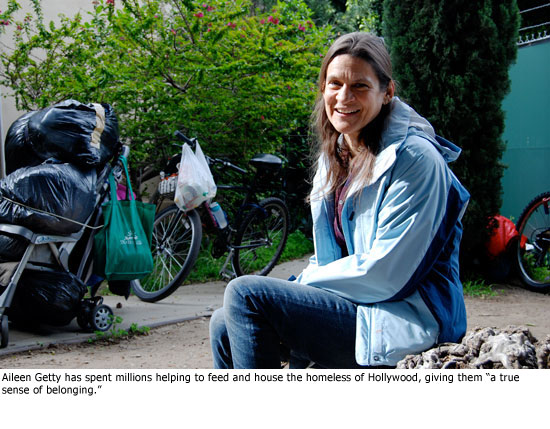
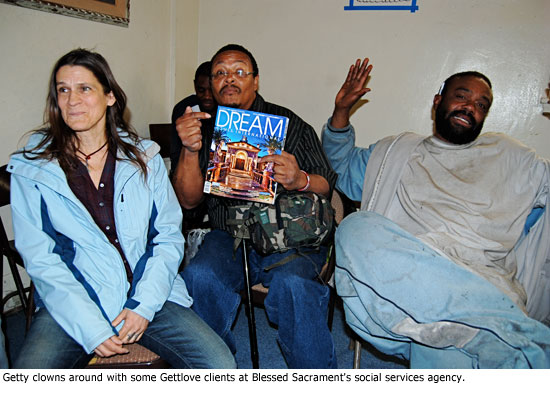






 405 bridge work causes a stink
405 bridge work causes a stink





